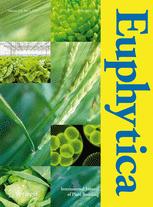Ver ítem
- xmlui.general.dspace_homeCentros Regionales y EEAsCentro Regional Mendoza - San JuanEEA La ConsultaArtículos científicosxmlui.ArtifactBrowser.ItemViewer.trail
- Inicio
- Centros Regionales y EEAs
- Centro Regional Mendoza - San Juan
- EEA La Consulta
- Artículos científicos
- Ver ítem
Multiallelic digenic control of vernalization requirement in carrot (Daucus carota L.)
Resumen
Carrots are typically classified as annual or biennial, depending on their vernalization requirement for flowering, a trait that is genetically-conditioned. Wild carrots are predominantly annual, requiring less hours of cold temperatures for flower induction, whereas most cultivated carrots are biennial (i.e., they have higher cold temperature requirements). After vernalization, if followed by long days, floral stem elongation and flowering take place.
[ver mas...]
Carrots are typically classified as annual or biennial, depending on their vernalization requirement for flowering, a trait that is genetically-conditioned. Wild carrots are predominantly annual, requiring less hours of cold temperatures for flower induction, whereas most cultivated carrots are biennial (i.e., they have higher cold temperature requirements). After vernalization, if followed by long days, floral stem elongation and flowering take place. Previous studies using F2 and BC1 families derived from crosses between an early and a late-flowering line revealed segregation ratios consistent with a monogenic trait, with annual habit being dominant over biennial. In this work, we studied inheritance and segregation of the vernalization requirement in carrot F2 populations derived from crosses involving carrots of different genetic backgrounds and geographical origins. Nine crosses between biennial and annual phenotypes were analyzed, for 2 years, by means of percentage of flowering plants (parental lines, F1 and F2 families were sown in the fall for adequate discrimination between annual and biennial plants). Based on the obtained segregation ratios, a genetic model for this trait was proposed. The results are consistent with a model of two genes (Vrn-A and Vrn-B) with three alleles controlling the vernalization requirement. Dominance of annuality was clear for both genes, with A1 allele having an epistatic effect over Vrn-B. Vrn-A and Vrn-B interact generating different vernalization requirement levels.
[Cerrar]

Fuente
Euphytica 215 : 37 (February 2019)
Fecha
2019-02
Editorial
Springer
ISSN
0014-2336
1573-5060
1573-5060
Formato
pdf
Tipo de documento
artículo
Palabras Claves
Derechos de acceso
Restringido
 Excepto donde se diga explicitamente, este item se publica bajo la siguiente descripción: Creative Commons Attribution-NonCommercial-ShareAlike 2.5 Unported (CC BY-NC-SA 2.5)
Excepto donde se diga explicitamente, este item se publica bajo la siguiente descripción: Creative Commons Attribution-NonCommercial-ShareAlike 2.5 Unported (CC BY-NC-SA 2.5)

